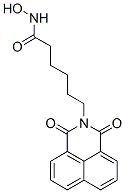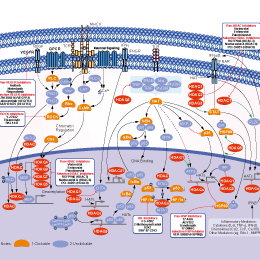
- Bioactive Compounds
- By Signaling Pathways
- PI3K/Akt/mTOR
- Epigenetics
- Methylation
- Immunology & Inflammation
- Protein Tyrosine Kinase
- Angiogenesis
- Apoptosis
- Autophagy
- ER stress & UPR
- JAK/STAT
- MAPK
- Cytoskeletal Signaling
- Cell Cycle
- TGF-beta/Smad
- DNA Damage/DNA Repair
- Compound Libraries
- Popular Compound Libraries
- Customize Library
- Clinical and FDA-approved Related
- Bioactive Compound Libraries
- Inhibitor Related
- Natural Product Related
- Metabolism Related
- Cell Death Related
- By Signaling Pathway
- By Disease
- Anti-infection and Antiviral Related
- Neuronal and Immunology Related
- Fragment and Covalent Related
- FDA-approved Drug Library
- FDA-approved & Passed Phase I Drug Library
- Preclinical/Clinical Compound Library
- Bioactive Compound Library-I
- Bioactive Compound Library-Ⅱ
- Kinase Inhibitor Library
- Express-Pick Library
- Natural Product Library
- Human Endogenous Metabolite Compound Library
- Alkaloid Compound LibraryNew
- Angiogenesis Related compound Library
- Anti-Aging Compound Library
- Anti-alzheimer Disease Compound Library
- Antibiotics compound Library
- Anti-cancer Compound Library
- Anti-cancer Compound Library-Ⅱ
- Anti-cancer Metabolism Compound Library
- Anti-Cardiovascular Disease Compound Library
- Anti-diabetic Compound Library
- Anti-infection Compound Library
- Antioxidant Compound Library
- Anti-parasitic Compound Library
- Antiviral Compound Library
- Apoptosis Compound Library
- Autophagy Compound Library
- Calcium Channel Blocker LibraryNew
- Cambridge Cancer Compound Library
- Carbohydrate Metabolism Compound LibraryNew
- Cell Cycle compound library
- CNS-Penetrant Compound Library
- Covalent Inhibitor Library
- Cytokine Inhibitor LibraryNew
- Cytoskeletal Signaling Pathway Compound Library
- DNA Damage/DNA Repair compound Library
- Drug-like Compound Library
- Endoplasmic Reticulum Stress Compound Library
- Epigenetics Compound Library
- Exosome Secretion Related Compound LibraryNew
- FDA-approved Anticancer Drug LibraryNew
- Ferroptosis Compound Library
- Flavonoid Compound Library
- Fragment Library
- Glutamine Metabolism Compound Library
- Glycolysis Compound Library
- GPCR Compound Library
- Gut Microbial Metabolite Library
- HIF-1 Signaling Pathway Compound Library
- Highly Selective Inhibitor Library
- Histone modification compound library
- HTS Library for Drug Discovery
- Human Hormone Related Compound LibraryNew
- Human Transcription Factor Compound LibraryNew
- Immunology/Inflammation Compound Library
- Inhibitor Library
- Ion Channel Ligand Library
- JAK/STAT compound library
- Lipid Metabolism Compound LibraryNew
- Macrocyclic Compound Library
- MAPK Inhibitor Library
- Medicine Food Homology Compound Library
- Metabolism Compound Library
- Methylation Compound Library
- Mouse Metabolite Compound LibraryNew
- Natural Organic Compound Library
- Neuronal Signaling Compound Library
- NF-κB Signaling Compound Library
- Nucleoside Analogue Library
- Obesity Compound Library
- Oxidative Stress Compound LibraryNew
- Plant Extract Library
- Phenotypic Screening Library
- PI3K/Akt Inhibitor Library
- Protease Inhibitor Library
- Protein-protein Interaction Inhibitor Library
- Pyroptosis Compound Library
- Small Molecule Immuno-Oncology Compound Library
- Mitochondria-Targeted Compound LibraryNew
- Stem Cell Differentiation Compound LibraryNew
- Stem Cell Signaling Compound Library
- Natural Phenol Compound LibraryNew
- Natural Terpenoid Compound LibraryNew
- TGF-beta/Smad compound library
- Traditional Chinese Medicine Library
- Tyrosine Kinase Inhibitor Library
- Ubiquitination Compound Library
-
Cherry Picking
You can personalize your library with chemicals from within Selleck's inventory. Build the right library for your research endeavors by choosing from compounds in all of our available libraries.
Please contact us at info@selleckchem.com to customize your library.
You could select:
- Antibodies
- Bioreagents
- qPCR
- 2x SYBR Green qPCR Master Mix
- 2x SYBR Green qPCR Master Mix(Low ROX)
- 2x SYBR Green qPCR Master Mix(High ROX)
- Protein Assay
- Protein A/G Magnetic Beads for IP
- Anti-Flag magnetic beads
- Anti-Flag Affinity Gel
- Anti-Myc magnetic beads
- Anti-HA magnetic beads
- Magnetic Separator
- Poly DYKDDDDK Tag Peptide lyophilized powder
- Protease Inhibitor Cocktail
- Protease Inhibitor Cocktail (EDTA-Free, 100X in DMSO)
- Phosphatase Inhibitor Cocktail (2 Tubes, 100X)
- Cell Biology
- Cell Counting Kit-8 (CCK-8)
- Animal Experiment
- Mouse Direct PCR Kit (For Genotyping)
- New Products
- Contact Us
Scriptaid
Synonyms: GCK 1026
Scriptaid (GCK 1026) is an inhibitor of HDAC. It shows a greater effect on acetylated H4 than H3.

Scriptaid Chemical Structure
CAS No. 287383-59-9
Purity & Quality Control
Batch:
Purity:
99.22%
99.22
Scriptaid Related Products
Signaling Pathway
Biological Activity
| Description | Scriptaid (GCK 1026) is an inhibitor of HDAC. It shows a greater effect on acetylated H4 than H3. | |
|---|---|---|
| Targets |
|
| In vitro | ||||
| In vitro | Scriptaid (6 μM) results in a >100-fold increase in histone acetylation in PANC-1 cell. Scriptaid (8 μM) is not lethal to PANC-1 cell and has limited effects (80% survival) on MDAMB-468. Scriptaid increases the transcription of pCMVb, p6SBE-luc and p6MBE-luc independent of a positive inducer of transcription. Scriptaid is capable of inducing high expression of p6MBE-luc, pCMVb, and pUB6/V5-LacZ, driven by viral (SV40 and CMV) or human (ubiquitin c, UB6) promoters, which do not depend on the specificity of the enhancer (SBE versus MBE), the type of promoter (viral versus cellular), the product of the reporter gene (luciferase versus b-gal), nor on the integration status of the reporter construct. [1] Scriptaid induces high rates of somatic cell nuclear transfer (SCNT) oocytes development to the blastocyst stage and allowed full-term development (3.4, 4.2, 7.6, 6.8, and 4.1%) with all concentrations (50, 100, 250, 500, and 2000 nM respectively). Scriptaid improves the full-term development of cloned B6D2F1embryos in a dose-dependent manner with the maximum effect at 250 nM. Scriptaid enables the clone of all the important inbred mouse strains, such as C57BL/6, C3H/He, DBA/2, and 129/Sv. Scriptaid treatment enhances newly synthesized mRNA levels in cloned embryos. 250 nM Scriptaid treated for up to 48 h, does not inhibit the development of ICSI-fertilized embryos. [2] Scriptaid inhibits T. gondii tachyzoite proliferation with IC50 of 39 nM. Scriptaid (0.225 μM) completely protects the HS68 monolayers from T. gondii tachyzoite. [3] Scriptaid inhibits growth of ER negative cell lines, MDA-MB-231, MDA-MB-435 and Hs578t with IC50 of 0.5-1.0 μg/mL after 48 h treatment. 1 μg/ml Scriptaid treated for 48 h induces an accumulation of both acetylated H3 and acetylated H4 histone tail proteins, and a maximal of 20,000-fold increase of ER mRNA transcript. [4] Scriptaid inhibits the proliferation and viability of the Ishikawa endometrial cancer cell line, and the SK-OV-3 ovarian cancer cell line with IC50 of 9 μM and 55 μM, respectively, while the normal human endometrial epithelial cells shows little sensitivity. Endometrial cancer cells and ovarian cancer cells cultured for 2 days in the presence of Scriptaid shows an accumulation in the G0/G1 phase (5 μM of Scriptaid) and G2/M phase (10 μM of Scriptaid) of the cell cycle, with a concomitant decrease in the proportion of those in the S phase. 10 μM of Scriptaid induces a 56.1% of apoptotic Ishikawa cells with loss of mitochondrial membrane potential, and decreased levels of cyclin A and bcl-2 levels by 50% and 20%, respectively. [5] | |||
|---|---|---|---|---|
| Kinase Assay | Immunoblotting assay of histone acetylation | |||
| PANC-1 cells are treated with 2 μg/mL of Scriptaid for 18 h in culture medium. Treated and untreated cells are harvested with trypsin-EDTA, washed with PBS, and resuspended in a protein sample buffer. Protein concentration is determined by BCA protein assay reagents. Fifty μg of proteins from each sample is loaded on a 12% denaturing polyacrylamide gel. Proteins are subsequently transferred to a nylon membrane using MilliblotGraphite Electroblotter I. The nylon membrane is incubated with rabbit antihuman acetyl-lysine antibody, followed by goat antirabbit antibody coupled to horseradish peroxidase, developed with SuperSignal substrates, and detected by film. | ||||
| Cell Research | Cell lines | Human breast cancer cells MDA-MB-231 | ||
| Concentrations | ~10 μg/mL | |||
| Incubation Time | 3 days | |||
| Method | Cells are plated at a cell density of 5000 cells/well in 12 well plates and treated with Scriptaid for up to 3 days. Cells numbers are counted daily using a Coulter counter. | |||
| In Vivo | ||
| In vivo | Scriptaid elicits a dose-dependent decrease in lesion size (a maximal decrease of 45%) at 1.5 to 5.5 mg/kg and a concomitant attenuation in motor and cognitive deficits when delivered 30 minutes postinjury in a model of mode rate TBI. Comparable protection is achieved even when treatment is delayed to 12 h postinjury. The protection of motor and cognitive functions is long lasting, as similar improvements are detected 35 days postinjury. Scriptaid induces an increase in surviving neurons (42%), as well as the number/length of their processes within the CA3 region of the hippocampus and the pericontusional cortex. Scriptaid treatment prevents the decrease in phospho-AKT (p-AKT) and phosphorylated phosphatase and tensin homolog deleted on chromosome 10 ( p-PTEN) induced by TBI in cortical and CA3 hippocampal neurons. [6] Scriptaid treatment (3.5 mg/kg) clearly inhibits tumor growth in a human breast cancer xenograft MDA-MB-231 model, reducing tumor volume by 75%. [4] | |
|---|---|---|
| Animal Research | Animal Models | Human breast carcinoma xenografts MDA-MB-231 |
| Dosages | 3.5 mg/kg | |
| Administration | intraperitoneally for five consecutive days with 2 days rest each week for a total of 4 weeks | |
Chemical Information & Solubility
| Molecular Weight | 326.35 | Formula | C18H18N2O4 |
| CAS No. | 287383-59-9 | SDF | Download Scriptaid SDF |
| Smiles | C1=CC2=C3C(=C1)C(=O)N(C(=O)C3=CC=C2)CCCCCC(=O)NO | ||
| Storage (From the date of receipt) | |||
|
In vitro |
DMSO : 65 mg/mL ( (199.17 mM) Moisture-absorbing DMSO reduces solubility. Please use fresh DMSO.) Water : Insoluble Ethanol : Insoluble |
Molecular Weight Calculator |
|
In vivo Add solvents to the product individually and in order. |
In vivo Formulation Calculator |
|||||
Preparing Stock Solutions
Molarity Calculator
In vivo Formulation Calculator (Clear solution)
Step 1: Enter information below (Recommended: An additional animal making an allowance for loss during the experiment)
mg/kg
g
μL
Step 2: Enter the in vivo formulation (This is only the calculator, not formulation. Please contact us first if there is no in vivo formulation at the solubility Section.)
% DMSO
%
% Tween 80
% ddH2O
%DMSO
%
Calculation results:
Working concentration: mg/ml;
Method for preparing DMSO master liquid: mg drug pre-dissolved in μL DMSO ( Master liquid concentration mg/mL, Please contact us first if the concentration exceeds the DMSO solubility of the batch of drug. )
Method for preparing in vivo formulation: Take μL DMSO master liquid, next addμL PEG300, mix and clarify, next addμL Tween 80, mix and clarify, next add μL ddH2O, mix and clarify.
Method for preparing in vivo formulation: Take μL DMSO master liquid, next add μL Corn oil, mix and clarify.
Note: 1. Please make sure the liquid is clear before adding the next solvent.
2. Be sure to add the solvent(s) in order. You must ensure that the solution obtained, in the previous addition, is a clear solution before proceeding to add the next solvent. Physical methods such
as vortex, ultrasound or hot water bath can be used to aid dissolving.
Tech Support
Answers to questions you may have can be found in the inhibitor handling instructions. Topics include how to prepare stock solutions, how to store inhibitors, and issues that need special attention for cell-based assays and animal experiments.
Tel: +1-832-582-8158 Ext:3
If you have any other enquiries, please leave a message.
* Indicates a Required Field
Tags: buy Scriptaid | Scriptaid supplier | purchase Scriptaid | Scriptaid cost | Scriptaid manufacturer | order Scriptaid | Scriptaid distributor







































